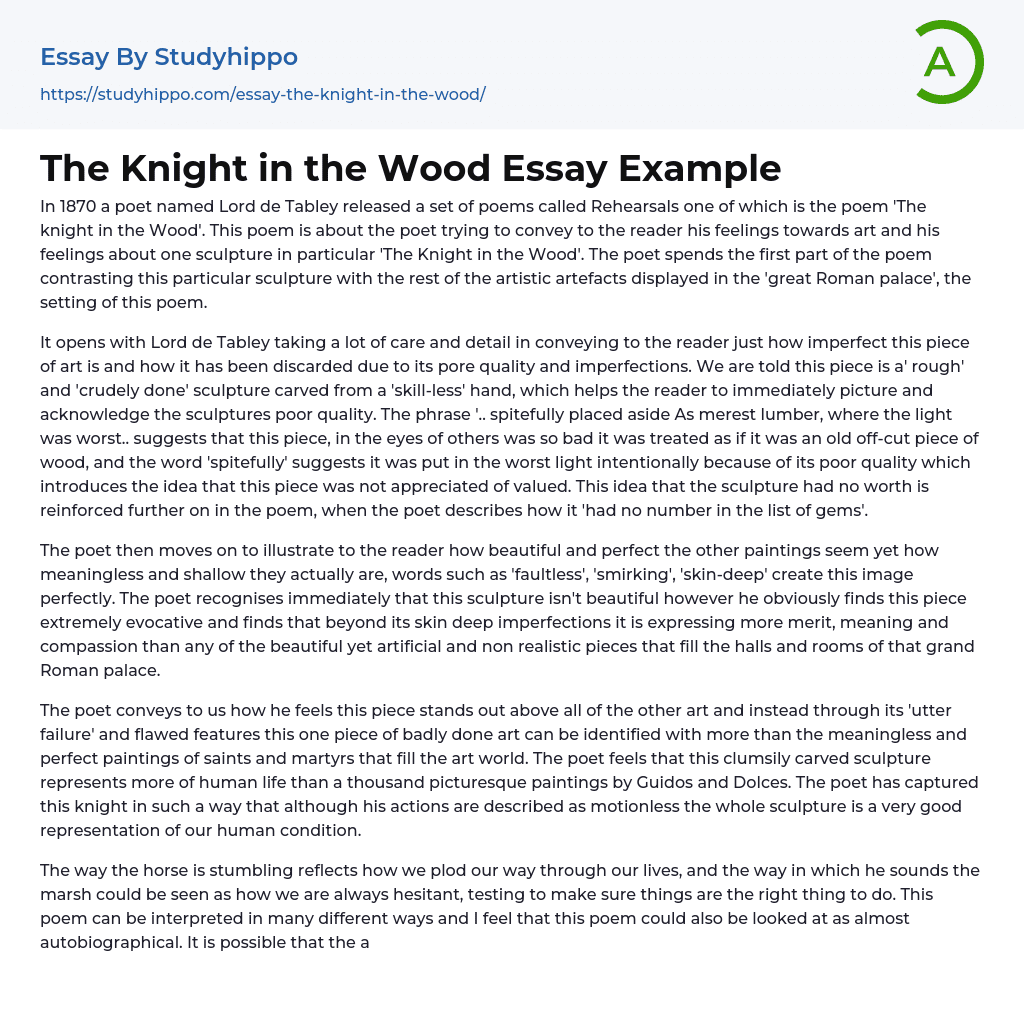Lord de Tabley, a poet, published a collection of poems called Rehearsals in 1870. One of the poems in this collection is 'The Knight in the Wood', in which the poet expresses his emotions towards art and specifically towards one sculpture. The poet devotes the initial section of the poem to drawing a comparison between this specific sculpture and the other artistic objects showcased in the 'great Roman palace', where the poem takes place.
The opening of the poem emphasizes Lord de Tabley's meticulous attention to detail in depicting the imperfections and low quality of a sculpture. It is described as a "rough" and "crudely done" piece, created by an unskilled hand, effectively conveying its poor craftsmanship. The phrase "...spitefully placed aside As merest lumber, where the light was worst..." suggests that others regarded it as worthless, treating it like an old
...piece of wood and intentionally placing it in unfavorable lighting to highlight its deficiencies. The use of "spitefully" implies that it was intentionally devalued due to its poor quality. This notion is further reinforced later in the poem when the poet mentions that the sculpture was not even considered among the valuable gems.
The poet proceeds to portray the reader with a depiction of the apparent beauty and flawlessness of the other paintings, while highlighting their lack of depth and significance. With descriptors such as 'faultless', 'smirking', and 'skin-deep', the poet effectively conveys this notion. Although acknowledging the lack of beauty in this particular sculpture, the poet finds it profoundly moving and recognizes that beneath its superficial imperfections, it conveys more value, meaning, and empathy than any of the artificially perfect and unrealisti
pieces that adorn the corridors and chambers of the magnificent Roman palace.
The poet suggests that amidst all the other works of art, this particular piece stands out because of its "utter failure" and flawed characteristics. Rather than the meaningless and flawless paintings of saints and martyrs that dominate the art world, this poorly executed sculpture can actually symbolize more about human life. The poet believes that this clumsily carved knight captures the essence of our existence, even though his movements are described as motionless. In summary, this sculpture effectively represents the human condition.
The horse stumbling symbolizes our own slow and steady progression in life, while the sound it makes while traversing the marsh represents our constant cautiousness, always testing to ensure we are making the right choices. This poem can be interpreted in various ways, and I believe it could also be seen as an autobiographical reflection. It is likely that the art portrayed in this poem and the emotions conveyed about its lack of understanding or appreciation serve as a metaphor or mirror for the poet's own misunderstood and undervalued poetry.
Lord de Tably's poems were unconventional for the Victorian era, deviating from the traditional style of poetry. The poem's structure and techniques employed by Lord de Tably were highly atypical for the time. Key features such as the absence of stanzas, uninterrupted flow of the poem, and the lack of a regular rhyming pattern challenge the conventional norms observed in Victorian poetry.
Although there is no regular rhyming pattern, the poet has written in iambic meter at times, which adds consistency to the poem. Additionally, the poet has employed caesura extensively, introducing pauses within the
sentences. While this can make the poem feel somewhat disjointed, it also creates suspense, particularly in the final sentence where there is a pause before the last two words, 'That's all!'. This pause is uncommon and emphasizes the peculiarity of the statement 'That's all!'.
Firstly, the slang term "That's" is not typically seen in Victorian poetry. Secondly, the use of an exclamation mark gives it a modern feel. Lord de Tabley consistently incorporates negative language throughout the poem, resulting in a rather bleak atmosphere. However, it is the combination of the poem's theme and the pessimistic descriptions that ultimately contribute to its depressing nature. If we acknowledge the significance behind this poem and fully embrace the message the poet is attempting to convey, it forces us to contemplate the implications it has on our own lives.
If the intention of the poet is to convey that this flawed and doomed sculpture is a poignant depiction of human life, it is disheartening to consider that this 'doomed pair' situated in this 'treacherous ground', 'afraid to move forward and afraid to retreat', accurately mirrors our existence. Another interpretation of this poem is that human life is lonely and barren. The fact that the meanings hidden within this poem are connected to reality enhances its impact. What I found particularly powerful about this poem were these messages and their depiction through the sculpture of the knight.
- Creativity essays
- Art History essays
- Theatre essays
- Pastoral essays
- Visual Arts essays
- Postmodernism essays
- Symbolism essays
- ballet essays
- Color essays
- Modernism essays
- Mona Lisa essays
- Work of art essays
- Body Art essays
- Artist essays
- Cultural Anthropology essays
- Ethnography essays
- Aesthetics essays
- Realism essays
- Heritage essays
- Harlem Renaissance essays
- Concert Review essays
- Voice essays
- Theatre Of The Absurd essays
- Playwright essays
- Scotland essays
- Tennessee williams essays
- Design essays
- Graffiti essays
- Graphic essays
- Typography essays
- Painting essays
- Photography essays
- Sculpture essays
- Architecture essays
- Interior design essays
- Arch essays
- Area essays
- Tattoo essays
- Pablo Picasso essays
- Vincent Van Gogh essays
- Michelangelo essays
- Frida Kahlo essays
- Book Summary essays
- Metaphor essays
- Reader essays
- Rhyme essays
- Literary devices essays
- Villain essays
- Books essays
- Genre essays




